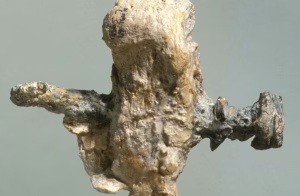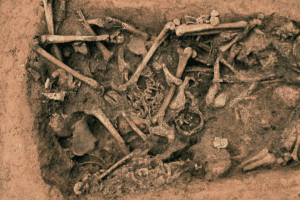
Reconstruction of Otzi the ice man
Archaeology has been responsible for the uncovering of some amazing finds over the centuries. But while we may marvel at the spectacular, it has also been guilty of uncovering haunted artefects. Here are five such artefacts you may want to be wary of getting too close to.
1. The Unlucky Mummy – British Museum, London
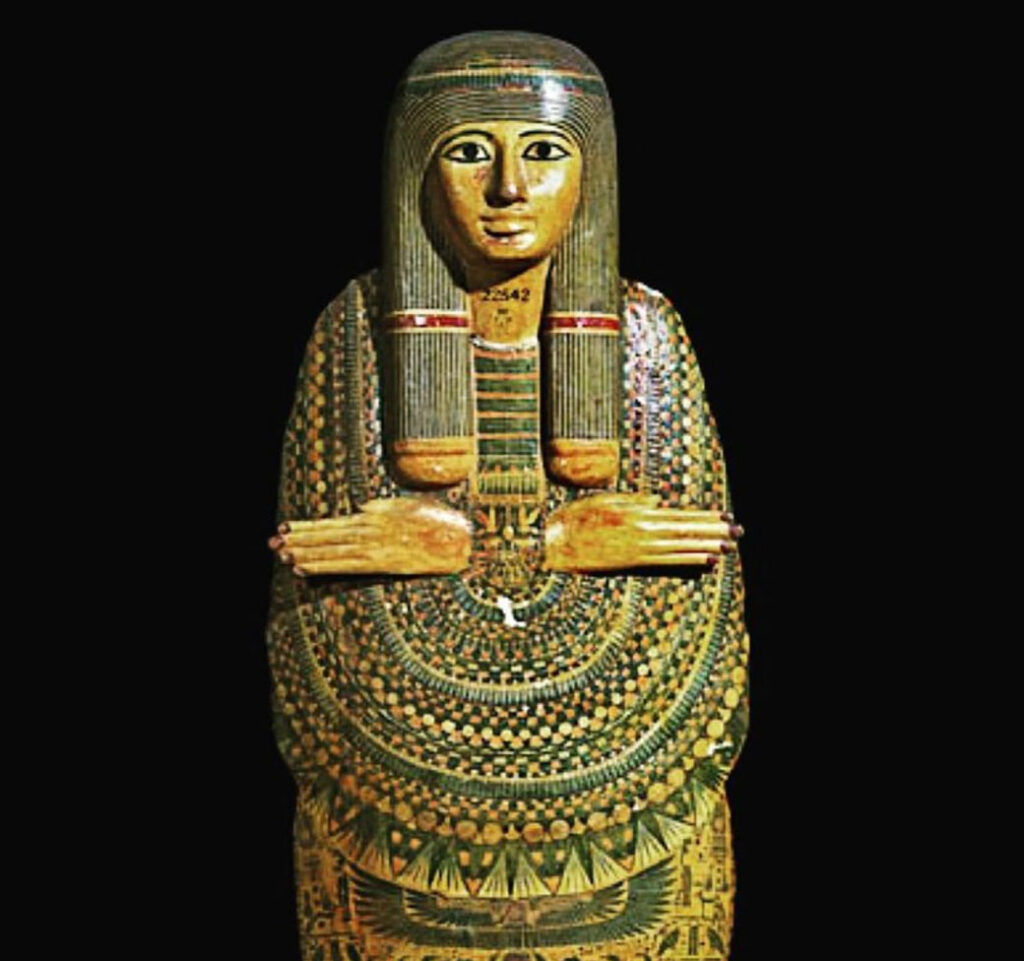
Despite the name, this isn’t a mummy at all, but a decorated coffin lid belonging to an ancient Egyptian priestess. Nicknamed the Unlucky Mummy, it allegedly brought catastrophe to every 19th-century owner who dared possess it. Mysterious deaths, financial ruin, house fires—the list of misfortunes grew so notorious that some blamed it for the sinking of the Titanic itself. (but the Titanic story is completely untrue as the object was in the British Museum at the time.)
According to the British Museum, the board was bought by four English travellers in the 1860s. Shortly after making the purchase, two of the four met an untimely end in shooting incidents. The other two? They appear to have fallen into severe poverty almost immediately and died shortly thereafter. The sister of one of the four took ownership, but her house met different misfortunes and a clairvoyant told her there was an evil presence in the board. So, she gave it to the British Museum.
Today, the painted board rests behind protective glass in the British Museum’s Egyptian galleries. Yet even now, specific night guards reportedly avoid lingering near its case after the lights go down, unsettled by the priestess’s painted eyes that seem to follow visitors through the shadows.
2. Tutankhamun’s Tomb Treasures – Egyptian Museum, Cairo
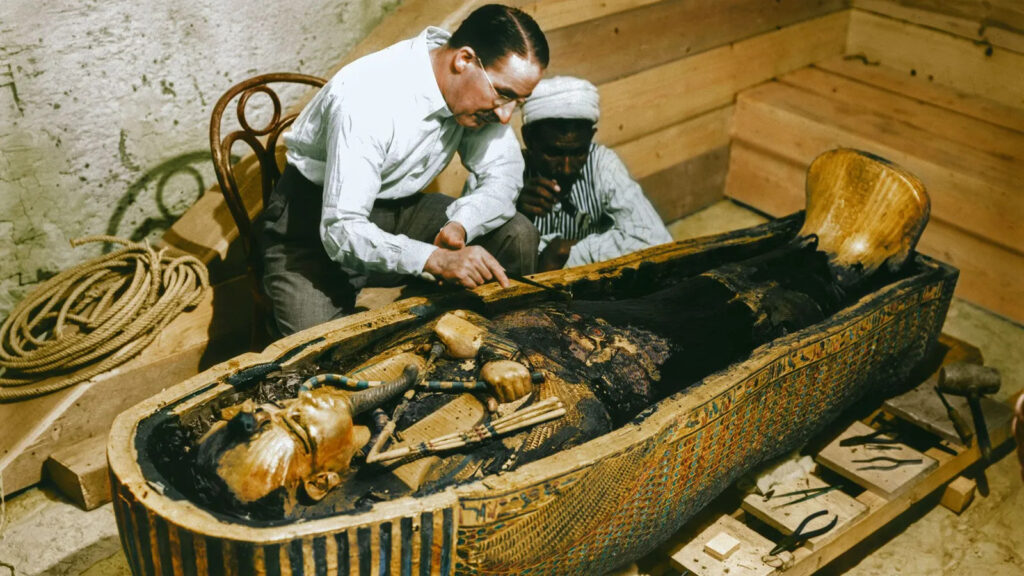
When Howard Carter breached the sealed doorway in 1922, he unleashed more than archaeological wonder. Within months of the tomb’s opening, Carter’s wealthy patron Lord Carnarvon died of blood poisoning from a mosquito bite. Then came more deaths—sudden, strange, unexplained. Journalists seized upon each tragedy, weaving the “Curse of the Pharaohs” into international legend.
A Feeling Of Being Watched
Most Egyptologists dismiss the curse as sensationalist fiction, citing that most deaths were natural causes and just a coincidence. However, the rumours persist: Even Carter himself, who lived for years after the discovery, admitted he couldn’t shake the feeling of being watched among Tut’s treasures.
3. The Hope Diamond – Smithsonian Institution, Washington, D.C.

This 45-carat blue diamond didn’t begin its journey in a museum display case. Stolen from an Indian temple statue centuries ago, it passed through the trembling hands of kings, merchants, and thieves—and nearly all met ruin, betrayal, or violent ends.
She Was Beheaded After Wearing The Diamond
Marie Antoinette wore it before her date with the guillotine. Later owners faced bankruptcy, madness, and mysterious deaths.
Now secured behind thick glass at the Smithsonian, the Hope Diamond draws millions of visitors annually. Many report an inexplicable unease standing before it—a creeping sense that its impossible beauty conceals something cold and watchful. This gemstone remembers every drop of blood spilt in its name.
4. Ötzi the Iceman – South Tyrol Museum of Archaeology, Italy
When hikers discovered a mummified body emerging from melting alpine ice in 1991, after their initial shock, they came to know that they’d found one of archaeology’s greatest treasures: a 5,000-year-old man, perfectly preserved with his tools, clothing, and final meal. But Ötzi’s gift to science came with a shadow that has followed people to this day.
Strange Deaths Seem To Follow Him
At least seven people connected to his discovery and study have died in bizarre circumstances—falling from mountains, killed in car crashes, succumbing to sudden illness. Coincidence? Perhaps. But stand before Ötzi’s refrigerated glass case, gazing at his leathery face and half-open eyes, and you might understand why some believe the Iceman doesn’t rest easy. His expression seems almost aware, watching each visitor with eyes that seem to follow them.
5. The Croesus Treasure Haunted Artefacts – Uşak Museum, Turkey
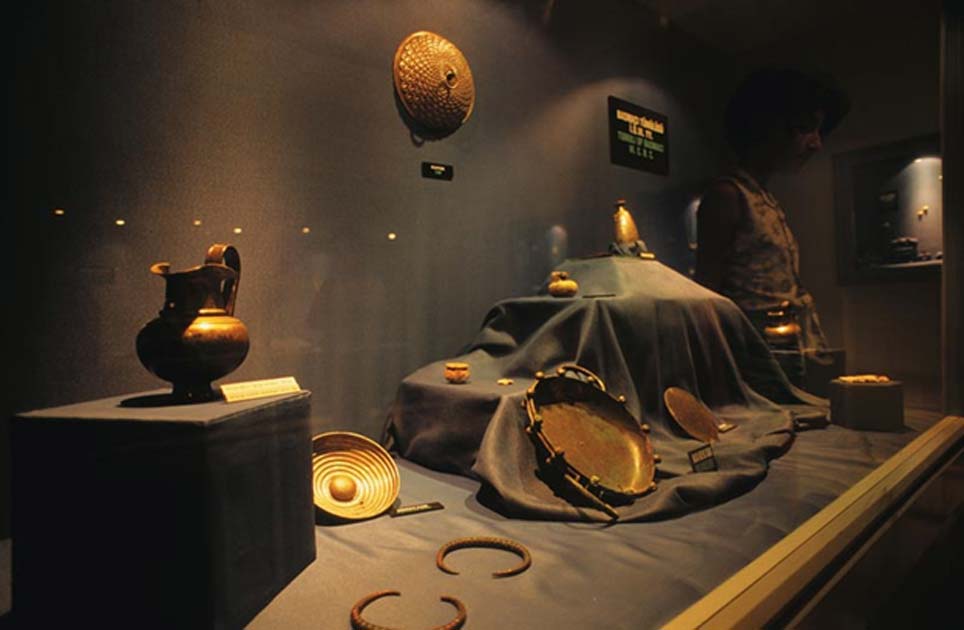
“Rich as Croesus,” the saying goes—but the 6th-century BCE Lydian king’s legendary wealth brought more than prosperity. In the 1960s, looters unearthed a spectacular hoard of Lydian gold from ancient tumuli. What followed was a trail of destruction: ruined careers, prison sentences, unexplained deaths, and an international smuggling scandal that embroiled the Metropolitan Museum of Art.
The Treasures Curse?
Eventually, after decades of legal battles, the glittering brooches, vessels, and jewellery now rest in Uşak. But locals still speak in hushed tones about the treasure’s curse—a reminder that gold torn from sacred ground demands payment, generation after generation.
Haunted Artefaces: a Final Whisper…
Archaeology provides us with windows into vanished worlds, but some objects refuse to remain quietly in the past. Whether curse, coincidence, or the darker corners of human imagination, these artefacts remind us: history isn’t always safely dead and distant.
Sometimes, across the glass and centuries, it stares back.
Sources & Further Reading
The Unlucky Mummy:
- British Museum – Egyptian Mummy Board EA 22542 (Official museum page)
- Project MUSE – “Blame the Mummy” scholarly article
Tutankhamun’s Tomb:
- The Explorers Club – “The Tomb That Changed the World”
- The Lancet – Medical analysis of Lord Carnarvon’s death
The Hope Diamond:
- Smithsonian – Official Hope Diamond History ⭐ (Best source!)
- Smithsonian Sidedoor Podcast – “The Curse of the Hope Diamond”
Ötzi the Iceman:
- South Tyrol Museum of Archaeology – Official Ötzi Page ⭐ (Primary source!)
- Britannica – Ötzi the Iceman
- University of Pennsylvania Museum – Ötzi Exhibition
The Croesus Treasure (Lydian Hoard/Karun Treasure):
- Smithsonian Magazine – “Chasing the Lydian Hoard” ⭐ (Excellent investigative piece!)
- University of Geneva – Lydian Hoard Legal Case
- Sardis Expedition – The Lydian Treasure

